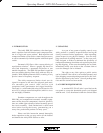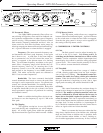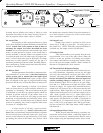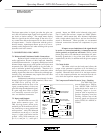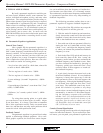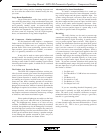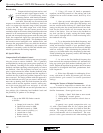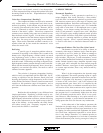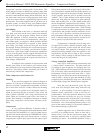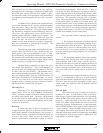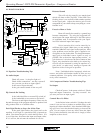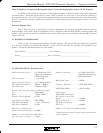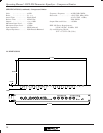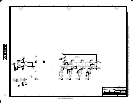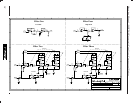
11
Operating Manual - DPX-200 Parametric Equalizer - Compressor/Limiter
singers whose own dynamic control is less than perfect.
A little compression helps to keep their quieter lines from
becoming buried in the mix. Experimentation is highly
recommended.
Voice-Over Compression (“Ducking”)
The compressor/limiter can be used to automati-
cally reduce music to a background level when an an-
nouncer is speaking. In this scheme, only the music signal
is actually gain-reduced by the limiter. However, the de-
tector is connected to respond to an announcer’s voice
instead of the music’s peaks. Voice-Over compression
assumes you are already using some sort of mixer to com-
bine the music and mic signals. Use the direct out (send)
of the mic channel to feed the detector input on the DPX-
200. Note: Be sure to use a mono plug for the detector
input. Then use the Threshold and Ratio controls to de-
termine when and by how much the announcer’s voice
affects the music level.
De-Essing
A special type of saturation problem often en-
countered in recording is the sibilant (Ssss) sound of the
human voice. High frequency, sibilant sounds can reach
very high energy levels, so that a voice that is otherwise
undistorted breaks up on the esses, producing a raspy, un-
desirable sound. With analog recording to magnetic tape,
high frequencies tend to saturate the tape sooner, and com-
bined with the internal high frequency boost (record pre-
emphasis) on standard tape decks, the need to control
sibilants becomes apparent.
The solution is frequency-dependent limiting,
which is easily accomplished with the DPX-200. By in-
serting an equalizer into the Detector Patch point and
boosting the equalizer at high frequencies in the vicinity
of the sibilant, the limiter’s detector circuit becomes more
sensitive to this particular range of frequencies, and so
will limit the bothersome sibilants more than other fre-
quencies.
Realize that this technique is very different from
simple equalization. Equalizing a sibilant vocal by cut-
ting high frequencies would result in a loss of important
high frequency information at all times, whereas de-essing
has no effect whatsoever on the signal except at the in-
stant of the sibilant. At that moment, the Ashly limiter
will reduce overall gain. Frequency response is unaf-
fected, and the sibilant is controlled.
9. DESIGN THEORY
Parametric Equalizers
The heart of Ashly parametric equalizers is a
unique bandpass filter circuit. Basically a “state-variable”
type, this filter is trimmed and optimized to provide excel-
lent transient response and a wide range of frequency and
bandwidth adjustment. Each filter can be tuned over a 100:1
frequency range (about 6.6 octaves) and a 70:1 bandwidth
range with no more than a 2 dB amplitude error at center
frequency. At its sharpest setting, the filter has a “Q” of
about 35 and generates a response curve with 3 dB points
only 1/20 octave apart, making feedback control possible
with no audible side effects. Each filter is placed in the feed-
back loop of a summing amplifier to produce the desired
frequency response. Since a separate summing amplifier
is used for each band, no interaction between bands oc-
curs.
Compressor/Limiters: The Need For Gain Control
The human ear excels in its ability to detect an
extremely wide range of loudness levels, from the quiet-
est whisper to roar of a jumbo jet. When we attempt to
reproduce this dynamic range, by means of amplifiers,
tape recorders, CD players, or radio transmitters, we run
into one of the fundamental limitations of these electronic
media: limited dynamic range. Amplifier dynamic range
is quite good, and is adequate for most musical program
material. However, some types of audio equipment, such
as cassette tape recorders, have a very narrow useful dy-
namic range.
What is it that compromises the dynamic range
of this equipment? The useful operating region of a piece
of audio equipment is squeezed in between noise and dis-
tortion. As program level decreases, it approaches what
is known as the “noise floor”, and if the volume of the
program material goes lower still, it is engulfed by the
noise. The noise floor, or minimum constant noise level,
will consist of hiss, hum, transistor noise, tape hiss, buzz
and whatever noises are inherent in the medium. When
the program level is considerably higher than the noise
floor, our hearing masks the noise, and it is not a prob-
lem. However, when listening to very quiet sections of a
program for example, a pause between movements of a
string quartet the noise can become very bothersome.
At the other end of the loudness spectrum, the
limitation on dynamic range is usually distortion, either
in the form of amplifier overload, tape saturation, or A to
D clipping. In most transistorized equipment, the transi-
tion from clean, undistorted operation to severe distor-
tion is very abrupt. Therefore, it is common practice to
operate a piece of equipment at a level that is somewhat
below the distortion point, leaving a margin of safety for



